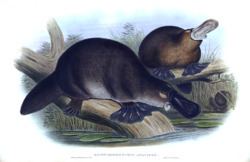Phylum Chordata | ||
 | ||
Infraclass AustralosphenidaLuo, Cifelli, & Kielan-Jaworowska, 2001 Similar Microbiotheria, Notoryctemorphia, Afrosoricida, Ambondro mahabo, Shrew opossum | ||
The Australosphenida are an infraclass of mammals. Today, there are only five surviving species, which live in Australia and New Guinea, but fossils have been found in Madagascar and Argentina. The surviving species consist of the platypus and four species of echidna.
Contents
Taxonomy
This grouping includes the following taxa:
The clade Australosphenida was proposed by Luo et al. (2001, 2002) and was initially left unranked, as the authors do not apply the Linnaean hierarchy. In Benton (2005), it is ranked as a 'superdivision', i.e. one or two levels below the infraclass.
Australosphenid teeth
The grouping embodies a hypothesis about the evolution of molar teeth in mammals. Living monotremes are toothless as adults, but the juvenile platypus, fossil monotremes and Ausktribosphenida all share a pattern of three molar cusps arranged in a triangle or V shape, which is known as the tribosphenic type of molar. Tribosphenic molars have long been held to characterize the subclass Theria (marsupials, placentals and their extinct relatives), while monotremes were thought to be related to fossil groups with a linear alignment of cusps: morganucodontids, docodonts, triconodonts and multituberculates, all of which were united with the monotremes into the 'subclass Prototheria'. Defined in this way, the 'Prototheria' is no longer recognised as a valid clade, since the linear cusp pattern is a primitive condition within Mammalia and cannot supply the shared derived character, which is required to establish a subgroup. Instead, the available evidence suggests that the monotremes descend from a Mesozoic radiation of tribosphenic mammals in the southern continents (hence the name Australosphenida, meaning 'southern wedges'), but this interpretation is highly controversial.
According to Luo et al., tribosphenic molars were evolved by the Australosphenida independently of the true Tribosphenida, or Boreosphenida (that is, the therians and their relatives) in the northern continents. Others contend that the Ausktribosphenida in fact belong to the placentals and were therefore true tribosphenids, but unrelated to the ancestry of the monotremes. If this were confirmed, it would entail abandoning the clade Australosphenida.
Most recent phylogenetic studies validate this clade, lumping henosferids and aukstribosphenids alongside monotremes.
